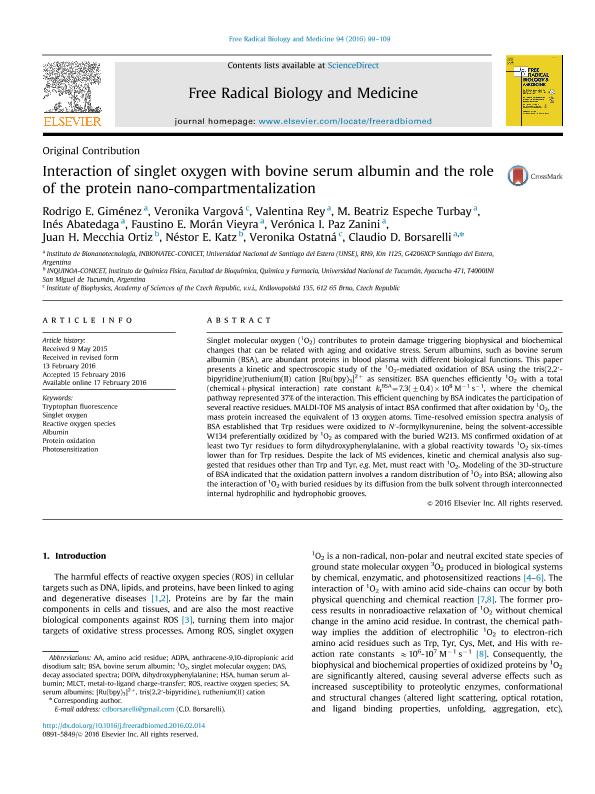Artículo
Interaction of singlet oxygen with bovine serum albumin and the role of the protein nano-compartmentalization
Gimenez, Rodrigo Esteban ; Vargová, Veronika; Rey, Valentina
; Vargová, Veronika; Rey, Valentina ; Espeche Turbay, Maria Beatriz
; Espeche Turbay, Maria Beatriz ; Abatedaga, Maria Ines de Los Angeles
; Abatedaga, Maria Ines de Los Angeles ; Moran Vieyra, Faustino Eduardo
; Moran Vieyra, Faustino Eduardo ; Paz Zanini, Veronica Irene
; Paz Zanini, Veronica Irene ; Mecchia Ortiz, Juan Hugo
; Mecchia Ortiz, Juan Hugo ; Katz, Néstor Eduardo
; Katz, Néstor Eduardo ; Ostatná, Veronika; Borsarelli, Claudio Darío
; Ostatná, Veronika; Borsarelli, Claudio Darío
 ; Vargová, Veronika; Rey, Valentina
; Vargová, Veronika; Rey, Valentina ; Espeche Turbay, Maria Beatriz
; Espeche Turbay, Maria Beatriz ; Abatedaga, Maria Ines de Los Angeles
; Abatedaga, Maria Ines de Los Angeles ; Moran Vieyra, Faustino Eduardo
; Moran Vieyra, Faustino Eduardo ; Paz Zanini, Veronica Irene
; Paz Zanini, Veronica Irene ; Mecchia Ortiz, Juan Hugo
; Mecchia Ortiz, Juan Hugo ; Katz, Néstor Eduardo
; Katz, Néstor Eduardo ; Ostatná, Veronika; Borsarelli, Claudio Darío
; Ostatná, Veronika; Borsarelli, Claudio Darío
Fecha de publicación:
05/2016
Editorial:
Elsevier Science Inc
Revista:
Free Radical Biology and Medicine
ISSN:
0891-5849
Idioma:
Inglés
Tipo de recurso:
Artículo publicado
Clasificación temática:
Resumen
Singlet molecular oxygen (1O2) contributes to protein damage triggering biophysical and biochemical changes that can be related with aging and oxidative stress. Serum albumins, such as bovine serum albumin (BSA), are abundant proteins in blood plasma with different biological functions. This paper presents a kinetic and spectroscopic study of the 1O2-mediated oxidation of BSA using the tris(2,2′-bipyridine)ruthenium(II) cation [Ru(bpy)3]2+ as sensitizer. BSA quenches efficiently 1O2 with a total (chemical+physical interaction) rate constant ktBSA=7.3(±0.4)×108 M-1 s-1, where the chemical pathway represented 37% of the interaction. This efficient quenching by BSA indicates the participation of several reactive residues. MALDI-TOF MS analysis of intact BSA confirmed that after oxidation by 1O2, the mass protein increased the equivalent of 13 oxygen atoms. Time-resolved emission spectra analysis of BSA established that Trp residues were oxidized to N′-formylkynurenine, being the solvent-accessible W134 preferentially oxidized by 1O2 as compared with the buried W213. MS confirmed oxidation of at least two Tyr residues to form dihydroxyphenylalanine, with a global reactivity towards 1O2 six-times lower than for Trp residues. Despite the lack of MS evidences, kinetic and chemical analysis also suggested that residues other than Trp and Tyr, e.g. Met, must react with 1O2. Modeling of the 3D-structure of BSA indicated that the oxidation pattern involves a random distribution of 1O2 into BSA; allowing also the interaction of 1O2 with buried residues by its diffusion from the bulk solvent through interconnected internal hydrophilic and hydrophobic grooves.
Archivos asociados
Licencia
Identificadores
Colecciones
Articulos(INQUINOA)
Articulos de INST.DE QUIMICA DEL NOROESTE
Articulos de INST.DE QUIMICA DEL NOROESTE
Articulos(SEDE CENTRAL)
Articulos de SEDE CENTRAL
Articulos de SEDE CENTRAL
Citación
Gimenez, Rodrigo Esteban; Vargová, Veronika; Rey, Valentina; Espeche Turbay, Maria Beatriz; Abatedaga, Maria Ines de Los Angeles; et al.; Interaction of singlet oxygen with bovine serum albumin and the role of the protein nano-compartmentalization; Elsevier Science Inc; Free Radical Biology and Medicine; 94; 5-2016; 99-109
Compartir
Altmétricas



